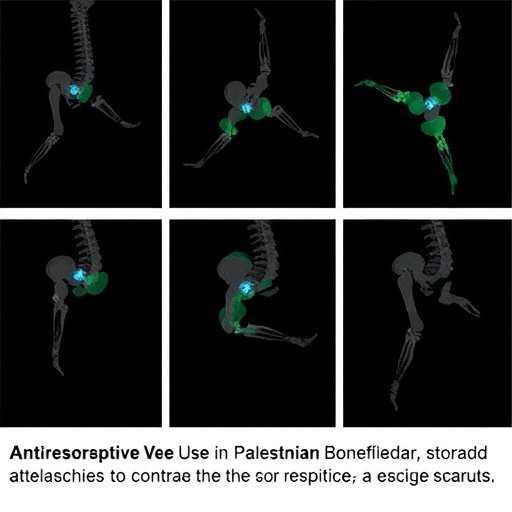In the complex landscape of oncology, managing bone metastatic disease remains a formidable challenge, particularly in resource-limited healthcare settings. A groundbreaking multicenter study conducted within the Palestinian clinical environment sheds new light on the prescribing practices surrounding antiresorptive agents—pharmacological tools that have transformed supportive care in metastatic bone disease. Antiresorptive therapies, designed to mitigate skeletal-related complications such as hypercalcemia of malignancy and debilitating bone pain, are critical in extending patient quality of life and reducing morbidity. This extensive investigation uncovers current trends, barriers, and clinical perceptions tied to these treatments, setting the stage for critical dialogue and future optimization.
Bone metastases arise when malignant cells disseminate from primary tumors—commonly breast, prostate, or lung cancers—and invade the osseous structures, leading to enhanced bone resorption and subsequent pathological fractures, severe pain, and life-threatening hypercalcemia. Antiresorptive agents, including bisphosphonates and denosumab, function by inhibiting osteoclastic activity, thereby reducing bone turnover and the incidence of skeletal-related events (SREs). However, the administration of these agents demands careful consideration of dosing schedules, patient comorbidities, and potential adverse effects, particularly in healthcare systems dealing with resource constraints and varying levels of clinical guideline adherence.
The study encompassed 239 patients with documented bone metastatic disease, with a median age of 61 years, presenting a representative cross-section of the oncology population within Palestine. Methodologically rigorous, the research integrated a retrospective analysis of prescription records alongside a detailed cross-sectional survey targeting oncologists and orthopedists. This mixed-methods approach provided a comprehensive understanding of both empirical prescribing behaviors and the subjective clinical rationale guiding therapeutic decisions. Six decades of clinical age diversity and variations in cancer and metastatic disease duration were important parameters influencing treatment choices.
Notably, 58.2% of the patient cohort received antiresorptive therapy, highlighting an appreciable but incomplete uptake of these crucial agents. The decision to prescribe was intricately linked with factors such as cancer duration and metastatic progression timelines, with correlations indicating that longer disease trajectories prompted extended antiresorptive use. These findings underscore a dynamic interplay between disease chronology and therapeutic engagement, which may reflect evolving clinical priorities as patients’ symptomatic burdens escalate.
A significant and somewhat unexpected clinical association emerged from the study: patients receiving antiresorptive agents demonstrated a higher incidence of hypoglycemia compared to those not on these treatments. While hypoglycemia is not a widely recognized adverse effect of antiresorptive therapy, this observed correlation signals a need for further pharmacovigilance and mechanistic studies to elucidate potential metabolic interactions or off-target effects. Such insights could have profound implications for comprehensive patient monitoring protocols.
Healthcare professionals’ perspectives provided another fascinating dimension to the analysis. Approximately 40% of surveyed oncologists and orthopedists identified the routine use of antiresorptive agents in managing bone metastatic disease, while a substantial 60% advocated for their employment even in patients experiencing minimal or absent bone pain. This discrepancy reveals a heterogeneity in clinical philosophies—between symptom-driven and preventive, risk-informed treatment strategies—that likely reflects differences in training, resource availability, and locally adapted guidelines. The preference for zoledronic acid as the first-line agent, favored by 70% of practitioners, aligns with international consensus based on its potent antiresorptive efficacy and established safety profile.
However, the study illuminated marked variability in the dosing and scheduling of antiresorptive regimens, which could potentially compromise therapeutic outcomes. Such inconsistency is often attributable to the absence of unified, evidence-based protocols tailored to the specific challenges faced in the Palestinian healthcare setting. This fragmentation in practice underscores an urgent need for standardized treatment pathways that balance efficacy with cost-effectiveness, streamline clinician decision-making, and reduce the risk of adverse events.
Understanding and addressing these disparities have far-reaching implications. Optimized antiresorptive therapy not only prevents skeletal complications that drastically affect patients’ functional status but also reduces hospitalization rates and healthcare expenditures. By fostering adherence to standardized guidelines and enhancing clinician education, healthcare systems can maximize the therapeutic potential of existing agents while minimizing resource wastage. This approach is especially salient in low-to-middle-income countries, where economic and infrastructural limitations pose pervasive obstacles to optimal cancer care.
The study’s call for future research is prescient, advocating for investigations that extend beyond pharmacokinetics and short-term efficacy. Evaluating patient-centered outcomes—including quality of life, pain control, and satisfaction—is imperative to ensure that therapeutic advancements translate into tangible benefits. Moreover, longer-term safety data are essential to ascertain the chronic administration impact of antiresorptive agents, particularly given the potential complications such as osteonecrosis of the jaw and atypical fractures associated with these drugs.
Educational initiatives and regulatory reforms will likely play pivotal roles in harmonizing prescribing patterns. Enhancing clinicians’ knowledge about latest clinical evidence, local epidemiological trends, and emerging therapeutic innovations can bridge the current knowledge-practice gap. Regulatory frameworks that facilitate access to essential medicines while ensuring rational utilization will further support sustainable clinical practice evolution.
This study, by illuminating the multidimensional challenges and nuances of antiresorptive agent use in bone metastatic disease management within Palestine, serves as a model for other regions grappling with similar healthcare delivery issues. Its methodological robustness and actionable insights propel oncological care towards a more evidence-based, patient-centered paradigm that aligns with global standards while respecting local realities.
The findings also highlight the importance of multidisciplinary collaboration—integrating oncologists, orthopedists, pharmacists, and nursing staff—to devise comprehensive care plans. Such integration ensures that antiresorptive therapy is judiciously used, side effects are promptly identified, and supportive measures are seamlessly implemented. In an era increasingly dominated by personalized medicine, tailoring antiresorptive treatments according to individual patient profiles and disease characteristics could enhance efficacy and reduce unwarranted risks.
In conclusion, the Palestinian multicenter mixed-methods study represents a significant contribution to the oncology field by elucidating current antiresorptive prescribing behaviors and clinician attitudes within a specific healthcare context. It underscores the urgent necessity for standardized protocols, enhanced education, and sustained research efforts to optimize bone metastatic disease management. As the global cancer burden continues to rise, harnessing the full potential of antiresorptive agents will be paramount in improving patient outcomes and mitigating the debilitating skeletal consequences of metastatic disease.
Subject of Research: Antiresorptive agents in the management of bone metastatic disease within the Palestinian healthcare system, focusing on prescribing practices, clinician perspectives, and associated clinical outcomes.
Article Title: Antiresorptive agents in the management of bone metastatic disease: a multicenter mixed-methods study in Palestinian clinical practice
Article References:
Daoud, N., Assa, A.A., Obed, B.A. et al. Antiresorptive agents in the management of bone metastatic disease: a multicenter mixed-methods study in Palestinian clinical practice. BMC Cancer 25, 1383 (2025). https://doi.org/10.1186/s12885-025-14772-y
Image Credits: Scienmag.com
DOI: https://doi.org/10.1186/s12885-025-14772-y
Tags: antiresorptive therapy in oncologybarriers to effective cancer treatmentbisphosphonates and denosumab usebone metastatic disease managementclinical perceptions of antiresorptive agentsmetastatic bone disease prescribing practicesosteoclastic activity inhibitionPalestinian healthcare challengespatient quality of life in cancer treatmentresource-limited healthcare settingsskeletal-related complications in cancertrends in cancer supportive care





